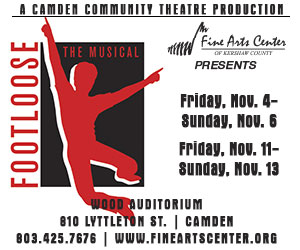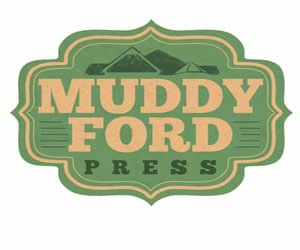Matthew Kramer
By Kristine Hartvigsen
Metal sculptor Matthew Kramer, 36, looks every bit the stereotypical blacksmith – burly, strong, and, well, kinda hairy. But look again. When the work gloves come off, those man-hands are sporting some pretty serious nail polish. Some days he goes with a glittery green or dark blue. He also likes lilac and the old stand-by, black. And though he looks somewhat like a bouncer in a biker bar, his buddies back in Milwaukee just call him “Bunny.”
“They thought it would be funny to call a 6-foot, 200-pound guy ‘Bunny,’” Kramer explains. “It just kind of stuck.” So the Columbia artist, who in his day job is a fabrication foreman (a.k.a. “shop overlord”) at Stuyck Company, eventually named his art studio Psycho Bunny Forge. “I was looking for something memorable,” he says.
Good fortune led Kramer and his wife, Vicki, to Columbia from Austin, Texas, in 2006 so she could attend graduate school at the University of South Carolina. The two met online through Internet Relay Chat (IRC) some 12 years earlier, just before the rest of the planet got logged into the World Wide Web. Kramer was still living in his native Milwaukee, and after a long-distance relationship lasting more than two years, he followed Vicki to Austin and married her. The central Texas town has become known as an emerging center for high-tech companies but also as a diverse arts and culture hub that plays host to such world-famous events as Austin City Limits Music Festival and the South by Southwest music and film festival. “That is one of the reasons we like Columbia,” Kramer says. “Columbia feels very much like Austin did 15 or 20 years ago. It’s right on the cusp of greatness.”
Though he studied fine art at Pennsylvania State University, Kramer remains just six credits shy of taking home his degree. That put him at a disadvantage arriving in a schizophrenic Midlands job market as the economy began to tank. “I could weld. My dad’s an architect, and I have been around the building industry most of my life,” Kramer explains. “But I was under-qualified for many jobs and over-qualified for others. For two years, I couldn’t find a job. So I started my own business.” That business was crafting high-end furniture. “I didn’t really make any money at it, but I made contacts.”
One of those contacts was Christopher Stuyck, owner of Stuyck Company, a creative metal fabrication business on Shop Road. The two hit it off right from the start. “Chris has an art background, so he understands that just because I don’t have the formal training doesn’t mean I can’t do the job,” Kramer says. “I started here as a grunt. I was bottom-rung and have worked my way up.”
In fact, Kramer and Stuyck soon collaborated on a monumental art project – the impressive 15-foot-tall steel sculpture in Five Points honoring Columbia’s own Hootie and the Blowfish. The privately funded public art project was a commission from the Five Points Association. “After we did the Hootie monument,” Kramer says, “we were approached to do Change for Change.”
Launched in 2010, Change for Change has become an annual community event in which local artists transform decommissioned parking meters into public art to generate awareness about sustainable practices and raise money for the Climate Protection Action Campaign. That year, Kramer created a Blue Heron out of a recycled meter, and folks around town began to take notice of the reclusive artisan’s talent.
Kramer’s entry in the 2011 program, “Lovely Rita, the Meter Maid,” caught the attention of City Center Partnership officials, who purchased it and, in conjunction with the City of Columbia, installed “Lovely Rita” at 1136 Washington Street in front of the city’s Parking Payment Center. Before that could happen, however, Kramer had to fatten Rita up, so to speak, to prepare her for her public.
“To install Rita, the whole structure had to be beefed up. The way I weld and do metal is very much the same way that I draw,” he explains. “I like open spaces with loose definitions. I like the idea of how it will be, but I want the viewer to fill it in.” So Rita was powder-coated, which is a process by which polyester vinyl or urethane plastic is very finely ground and given an electrical charge. Applied to a metal object that’s been oppositely charged, the powder clings to the piece, which is then heated. The powder melts and re-fuses with the piece to add color and rust protection. We see it all the time in playground equipment and bicycle racks around the city. Appropriately fortified, Rita was bolted to a granite block to remind art lovers and others to remember to feed their meters.
This spring, Kramer wowed people again with his entry in the annual “Painted Violins” fund-raiser for the South Carolina Philharmonic Orchestra. Each participating artist is given a single violin to decorate or repurpose in any way they please. Kramer fabulously created “The Grasshopper and the Ants,” a three-piece sculpture with a giant grasshopper standing over two ants, each ant crafted from half of a violin, oriented on its side, and given legs and antennae. It was a natural choice for Kramer, who gets his strongest inspiration from nature. “Before I went into art, I actually was considering a degree in natural resources management,” the artist says. “I love the outdoors and being out in nature.”
That works out well, because Kramer and his wife found a house near rural Eastover and have plenty of room for cast-off sculptures, their two dogs, and three cats. “Sculpture is noisy,” he quips. “Moving out to the country made sense.” Fortunately, the Kramers’ neighbors don’t seem to mind at all. “When they learned that I could do something useful, I became pretty popular,” Kramer says. “I was raised to be helpful, and I wouldn’t take their money. So they started paying me in vegetables from their garden.”
When you’re a metal sculptor, though, it can be a pretty expensive proposition to submit a piece of art, even for a good cause, again and again. There’s the cost of materials and, of course, a considerable labor commitment. Kramer entered the local art scene through the non-profit door, but even he had to consider ways to keep his costs in check when donating sculptures for charity.
One of the benefits of working for his good friend is receiving access to affordable materials. “Chris finds deals on semi-torn-up materials that people don’t want, but we can throw them on our plasma table and cut them up,” Kramer says. “Chris only charged me $50 for the metal I used for the Grasshopper,” which alone weighed about 80 pounds. Even so, that’s a respectable out-of-pocket expense to consider, on top of talent and, perhaps most remarkably, time.
“After Rita, I re-evaluated how I was doing things,” he says. “When I did the Blue Heron for Change for Change, it was only about a three- to five-hour piece for me. Rita took, on and off, about 80 hours over two weeks. … It can get expensive, but it is exposure. I am starting to make a name for myself in Columbia. I didn’t know the art scene here when I got here. Right now, I feel like I am paying my dues. I have to show what I can do and prove myself. The charity stuff helps with that.”
“Matt is one of the most philanthropic artists I know in this community and consistently contributes an incomparable amount of his time and talent to charitable causes,” says Anastasia Chernoff, curator of Anastasia & Friends Gallery on Main Street in Columbia. “His work never ceases to surprise and surpass. He’s intelligent, original, inspiring, and a true giver.”
Being invited to exhibit at Anastasia & Friends gallery was pivotal. “Anastasia Chernoff invited me to one of her First Thursday shows, and I have been showing there ever since,” Kramer says. “That was my first non-charity show in Columbia.” In fact, Kramer is gearing up for a solo show at Anastasia & Friends in September.
“I don’t believe there’s a single cell of mediocrity in Matthew Kramer. Over the last couple of years, he has participated in numerous shows at the gallery and become a good friend,” Chernoff says. “He’s artistically dynamic in every conceivable way – a perfectionist. Although he’s best known for his work with metal, I’ve seen some of his work in other mediums, and don’t think there’s a single material that he couldn’t cleverly master and fashion into something meaningful – he’s a true virtuoso.”
As his work continues to develop a following, Kramer hopes before long to create some large art installations, something he hasn’t really done since college. Of course, that means he’ll have to get out and schmooze, because such projects need sponsorship. “I am a hermit by nature,” he says, “so networking has never been my strong suit.” He is aware that he may have to step farther afield from his comfort zone for the sake of his art. “I wouldn’t say I’m coming out of my shell so much as feeling the need to put myself out there if I want to push the art side of my life forward,” he says.
Kramer is sure to make an impression at Anastasia & Friends in September. “I’ve settled on a theme of updated mythologies, along the lines of the satyrs using tools as symbols of modern masculinity to make statues of Greek symbols of masculinity and fertility,” he says. “And I will probably be remaking a centaur out of motorcycle and bicycle parts.”
“When I think of Matt, a word that instantly comes to mind is ‘wholehearted,’” Chernoff adds. “Matthew Kramer is an artist’s artist.”






.jpg)
